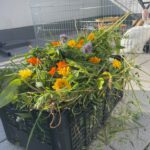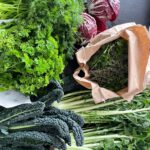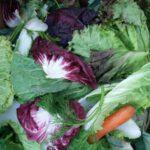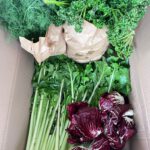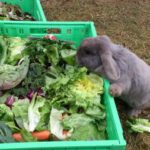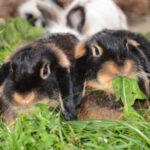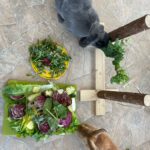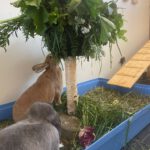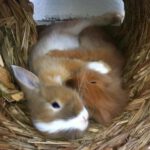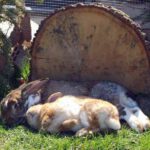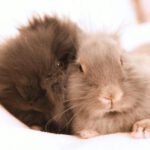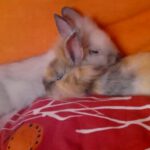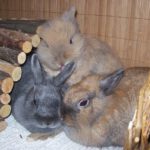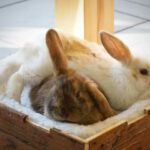Contents
Hay as the Main Food?
The restricted feeding based on hay is now outdated, but it is still common in pet circles. How this development originally came about can no longer be definitively traced, but it is certain that times of scarcity, the adoption of human meal rhythms, as well as practical reasons (low cost, minimal effort), played a role.
Restricted Feeding: A feeding method where hay is available to the rabbit around the clock, supplemented by one to three meals of fresh food. In contrast, with ad libitum feeding, fresh greens are offered in addition to hay in such large quantities that they also never run out.
A restricted feeding regimen inevitably has some consequences for rabbit health and leads to a diet primarily based on hay.
I would like to address a few issues related to restricted feeding (or high hay consumption) here.
The listed disadvantages apply when the animal consumes hay as the main portion of its diet. When hay is provided as a supplementary food (in addition to a varied diet of fresh greens), these points are not relevant.
Low Water Content in the Diet > Kidney and Bladder Diseases
In a restricted feeding regimen, hay is used as the primary food. Hay is extremely low in water content (plants contain 80-90% water, while dried foods have at most 15%), which leads to certain issues.
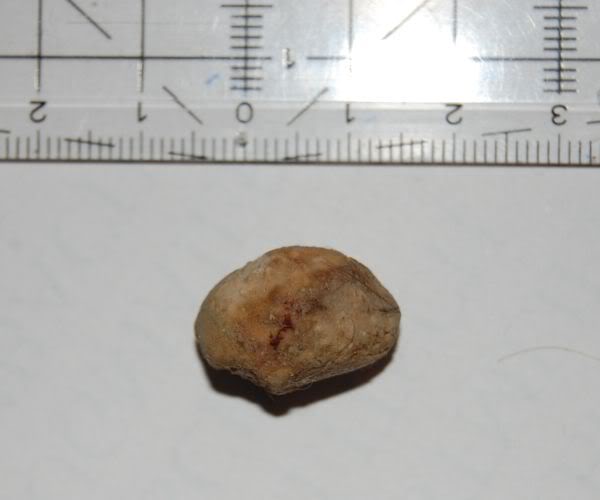
Due to a predominantly dry diet, less water is consumed, and rabbits do not fully compensate for the lack of water by drinking more. As a result, rabbits fed mainly fresh food take in the most water (Schwabe 1995, Wenger 1997).
The low fluid content in the diet (and consequently a lack of water in the body) leads to highly concentrated urine filled with minerals, which can accumulate. A low water content therefore promotes deposits in the kidneys and bladder (bladder stones, kidney stones, calcifications, urinary sludge, etc.) (Kamphues 2004).
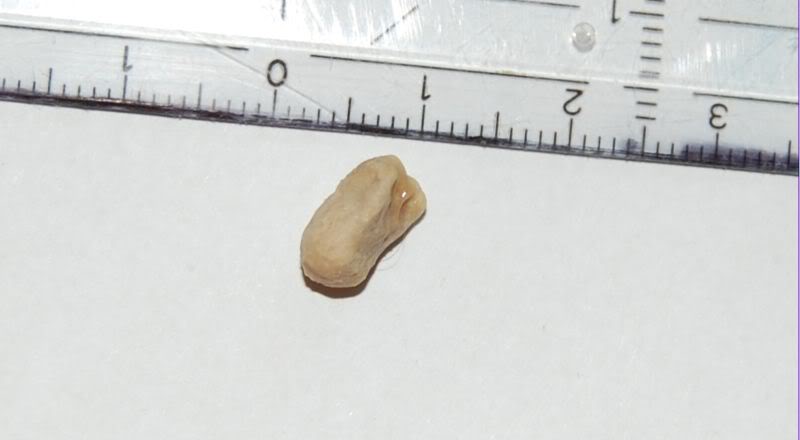
With limited water intake and a high calcium intake, the risk of bladder stone formation increases. However, this risk remains low as long as the urine volume is sufficiently high. The urine volume directly depends on the amount of water consumed […]. Increased water intake helps reduce the concentration of excretory substances in the urine, which plays an important role in calcium excretion and potential stone formation. In other words, the more water consumed, the lower the risk of bladder stone formation.“
— Dr. med. vet. Natalie Dillitzer: Rabbits in Nutritional Counseling in Small Animal Practice: Dogs, Cats, Reptiles, Guinea Pigs, Rabbits, Urban & Fischer, 2009.
In general, the high calcium content found in natural food must be balanced by a high water content in the diet (Kamphues 1989). A calcium-reduced diet is not species-appropriate, and without the water balance, it can lead to urolithiasis.
Further reading:
- Spennemann, B.: Urine Examination in Pet Rabbits, Free University of Berlin, 2002
- Rappold, St.: Comparative Studies on Urolithiasis in Rabbits and Guinea Pigs, Hanover Veterinary School, 2001
Loss of Vitamins and Nutrients > Deficiency Diseases
During the hay-making process, over 50% of the nutrients are lost solely due to the crumbling of the leaves. An additional 6-8% of nutrients are lost for each month of storage (Lackenbauer 2001). For fresh hay, this means that, in the best-case scenario, „only“ 59% of the nutrients have been lost (50% due to leaf loss and 9% due to 1.5 months of storage). With longer storage times, the nutrient content quickly approaches zero.
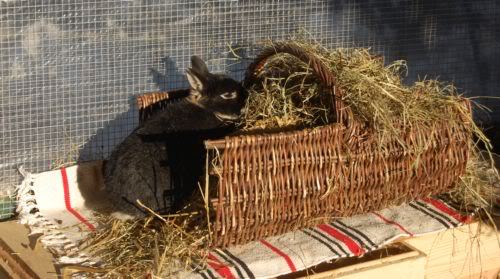
Here are some comparison data for fresh hay and grass (herbs are not included, as they would further exaggerate the differences) (Working Group for Active Substances in Animal Nutrition 2001):
- Grass contains an average of 200 mg of β-carotene and 200 mg of Vitamin E.
- High-quality green forage contains an average of 250 mg of β-carotene and 75 mg of Vitamin E.
- Hay contains an average of 20 mg of β-carotene and 30 mg of Vitamin E.
As we can see, hay is an extremely nutrient-poor feed. Rabbits rely on a higher nutrient content, as found in their natural food sources (fresh plants). They need to obtain vitamins through their diet, such as β-carotene and Vitamin E, which they cannot synthesize themselves (Lackenbauer 2001). Two servings of vegetables cannot compensate for the nutrient loss in hay to this extent.
Unnatural Food
Commercially available hay typically consists mainly of various cultivated grasses and has an extremely low proportion of herbs. However, rabbits are folivores (Schlolaut, W. 2003) and depend on a diet based on herbs and leafy components. During the hay-making process, leafy parts are lost due to mechanical handling, leaving only stems and grasses behind (Lackenbauer 2001). Normally, rabbits consume very little grass, and such a diet forces them to eat primarily grass.
Toxic Plants in Hay > Poisoning
Many toxic plants (e.g., buttercup) lose most of their harmful properties during the drying process, making them suitable for feeding. However, other toxic plants retain their toxins but lose their signaling effects, which help rabbits recognize them as poisonous (such as smell, taste, appearance, etc.). Since these plants break down in hay, they cannot be sorted out. As a result, it’s possible to inadvertently poison your rabbit with something like autumn crocus through hay. If this plant were offered fresh, rabbits would likely avoid it. See also: Selection of Toxic Plants. In dried plants, the signals are much weaker, so toxic plants are more likely to be consumed along with non-toxic ones.
Digestive Disorders
A hay-heavy and therefore dry diet is not only unsuitable (rabbits are fresh food eaters), but it also places a significant strain on digestion, promoting issues like constipation, hairballs, and bloating (due to constipation). Often, not all fresh foods are tolerated (fresh food intolerances).
Conclusion: No rabbit should be forced to eat hay. Rabbits should always have the option to switch to other food sources (fresh food and dried herbs) to avoid the disadvantages of hay feeding. Nevertheless, hay should always be available as a supplementary food.
A study on water intake with different drinking systems and dietary components also summarizes this issue well:
„For optimal hydration and prevention of urinary stones, we recommend a diet with a high proportion of ‚fresh (water-rich) foods,‘ along with unlimited access to hay and free access to water offered in an open bowl.“ (Translation)
Study: Anja Tschudin (University of Zurich) et al: Journal of Animal Physiology and Animal Nutrition, doi:10.1111/j.1439-0396.2010.01077.x
Sources, among others:
Arbeitsgemeinschaft für Wirkstoffe in der Tierernährung: Vitamine in der Tierernährung, 2001
Dahlhoff S.: Fruktangehalt im Gras von Pferdeweiden während der Weidesaison 2002; http://elib.tiho-hannover.de/dissertations/dahlhoffs_ws03.pdf (Stand 23. September 09), 2003
Dillitzer, N.: Kaninchen; in: Ernährungsberatung in der Kleintierpraxis: Hund, Katze, Reptilien, Meerschweinchen, Kaninchen. Urban&Fischer, 2009
Kamphues, J: Ca-Stoffwechsel bei Kaninchen – Bedeutung für die Kleintierpraxis, 35. Jahrestagung Fachgruppe Kleintierkrankheiten der DVG, 1989
Kamphues, J.: Häufige Fütterungsfehler und Hinweise zur Diätetik […]; Gemeinschaftsveranstaltung „Kleine Heimtiere. Diagnostik und Therapie von Erkrankungen des Verdauugsapparates“, 2004
Lackenbauer W.: Kaninchenfütterung. Artgerecht. naturnah. wirtschaftlich, 2001
Rappold, St.: Vergleichende Untersuchungen zur Urolithiasis bei Kaninchen und Meerschweinchen, Tierärztliche Hochschule Hannover, 2001
Schlolaut, W.: Das große Buch vom Kaninchen. 3. überarb. Auflage. DLG-Verlag GmBH, 2003
Schwabe, K.: Futter- und Wasseraufnahme von Heimtieren verschiedener Spezies (Kaninchen, Meerschweinchen, Chinchilla, Hamster) bei unterschiedlicher Art des Wasserangebotes, Tierärztl. Hochschule Hannover, 1995
Spennemann, B.: Harnuntersuchung beim Heimtierkaninchen; Freie Universität Berlin, 2002
Vanselow R.: Giftige Gräser auf Pferdeweiden, 2008
Wenger, A.: Vergleichende Untersuchungen zur Aufnahme und Verdaulichkeit verschiedener rohfaserreicher Rationen und Futtermittel bei Zwergkaninchen, Meerschweinchen und Chinchilla. Hannover, Tierärztliche Hochschule, 1997
Wolf, P., Cappai, M. G., & Kamphues, J. (2020): Water consumption in small mammals (dwarf rabbits, Guinea pigs and chinchillas): New data about possible influencing factors. Research in veterinary science, 133, 146-149.



